The term “hospital bed” conjures images of a sterile hospital room and often carries a stigma of illness or end-of-life. It is not something you choose to bring into your cozy home unless necessary for your health and recovery. But there are alternatives to a hospital bed, especially if you want to upgrade your bed for comfort and function as your needs change.
As we age, getting out of bed can feel more difficult due to arthritis, pain, limited mobility, stiff muscles, or other health-related factors. Most bed manufacturers do not consider how to accommodate a person who wishes to stay in their home and continue sleeping in a standard bed. Many doctors will recommend a hospital bed after an extended hospital stay or progressing healthcare needs. But if you are considering investing in this piece of durable medical equipment, consider if an alternative solution might better meet your needs. Moving from a standard bed to a twin-sized hospital bed can be a significant adjustment and, in some cases, unnecessary.
No longer limited to hospitals and skilled nursing facilities, patients of all ages may require hospital beds at home. They are a helpful tool to support people as they recuperate. If you are considering a hospital bed, the first step is to determine whether you are caring for someone with a temporary physical condition or a chronic need. To manage a catastrophic illness or an acute injury, a hospital bed may be required.
But many older people can benefit from an adjustable bed or a bed system such as the Dawn House hospital bed alternative to meet their needs as they age at home. It helps people maintain their independence, dignity, and quality of life with a bed that includes features to help them feel better and sleep more soundly. An adjustable bed for seniors will not be as bulky as a heavy-duty hospital bed which might do more harm to their quality of sleep than good.
How Does a Medical Bed Differ from Standard Beds?
A hospital bed's function and purpose are quite different from a standard bed. Through rigorous testing, certified home hospital beds must meet a stringent standard of mechanical and electric safety regulations. The safety features of a hospital bed are designed to keep a patient safe from falls and injury, making it easier to get in and out of bed safely. Hospital beds are designed to be portable, utilitarian, and easy to clean. Whereas a standard bed comes in a variety of size options and materials, has sleeker designs, is lighter weight to move, and often incorporates a decorative headboard. Unlike standard beds, hospital beds offer extra support and allow patients to move into positions that are not possible with a regular bed.
Many people find a hospital bed difficult to accommodate in their homes. Most look starkly out of place in a home or bedroom. With the larger footprint of a hospital bed, many cannot fit up a narrow staircase, through a doorway, or into a small bedroom. Some patients end up sleeping in the living room or den. They find it challenging to maintain a normal lifestyle when they are not sleeping next to their partner or even in the same room.
Hospital beds are meant for single occupancy. For that reason, most hospital beds are compatible with a twin XL mattress that are only about six inches thick. A thicker mattress will make it more difficult for the user to get in and out of the bed. Standard beds fit traditional-size linens and come in all widths.
If a doctor certifies that a home hospital bed is necessary for a patient’s condition, then Medicare, Medicaid, or private insurance may reimburse for the rental or purchase. The Dawn House bed is not covered by Medicare, Medicaid or other insurance and is a private pay product. While they cover hospital beds, a standard bed would not be paid for. And home hospital beds accommodate added medical features like IV hooks, safety rails, overhead trapeze support bars, and bed tables for eating meals.
How Does a Hospital Bed Differ from Adjustable Beds?
One advantage of renting or purchasing a hospital bed to replace your traditional bed is the height of the bed can adjust to accommodate a caregiver better. Hospital beds help caregivers to better assist and deliver quality care to their patients or loved ones. Raising or lowering the bed frame will alleviate back strain and help caregivers work with patients at a more comfortable height. Among adjustable beds on the market, very few raise and lower in height. In a Dawn House bed system, you can adjust the height of the bed, with the high/low feature, from your wireless remote, voice activated puck or in app remote. Each side of the split king frame moves independently so you won’t disturb your partner.
The similarities between hospital beds and adjustable beds are the users can adjust the head and foot of the bed. While awake or resting in bed, many people prefer to elevate their feet, knees, and/or head for better comfort and therapeutic reasons. Adjusting to an upright position allows the user to read a book, watch television, or eat a meal. Getting a proper night’s sleep is essential for healing, so being able to lay flat (if that is more comfortable) works well in an adjustable bed.
Although some features on an adjustable bed are similar in function to a home hospital bed, hospital beds are subject to FDA standards and covered by medical insurance when purchased or rented for healthcare purposes. Adjustable beds have been designed for the home, so they resemble a traditional bed with a headboard, size options, and a design that fits into your bedroom layout.
Different Types of Hospital Beds for Home
Hospital beds are designed to be adjustable and user-friendly, but not all are the same. The most common types of hospital beds for home care are:
Full Electric. Adjusting the bed is done electronically via a button panel or remote to raise and lower the bed frame and adjust the bed's head and foot. A full electric hospital bed is a good choice for home care because it allows the patient to control the electric adjustable bed without relying on a caregiver or family member to assist. Some come with a stand-assist feature that helps the patient rise and exit the bed independently. Full electric is the most common type of hospital bed and the most expensive.
Semi-Electric. The main components require manual action, while the smaller features require less power and are controlled electronically. For example, a lever may be used to adjust the height of the bed, while a remote adjusts the angle of the head and foot of the bed. The semi-electric hospital bed is more affordable but not recommended for long-term care.
Manual. Manual hospital beds are the most affordable choice because all adjustments are made manually, using a hand crank to raise and lower the head, foot, and height. It is most suitable for patients with an around-the-clock caregiver because they are bedridden.
Bariatric. Bariatric beds are designed to support plus-sized people. The standard hospital bed has a weight limit of between 400-600 pounds, but a bariatric bed can support individuals who exceed that limit by up to 1,000 pounds. These beds are wider and longer than a standard hospital bed.
Dawn House Offers Seniors an Alternative
Most people do not want their homes to feel like a hospital, even if they need care. Hospital beds are expensive, sterile, and feel out of place in a home. A helpful alternative to a hospital bed is the Dawn House bed system which has been designed to support the needs of older individuals with features that will make them more comfortable, independent, and safe—but with a beautiful aesthetic to compliment any home.
The health benefits of a Dawn House bed rival a hospital bed with an adjustable height that allows the person to get in and out of bed safely, making it easier for caregivers to support them. The articulated bed base allows for head and foot elevation to support better circulation and reduce back pain. An optional stylish support rail can be added to assist the user in entering and exiting the bed, but it won’t remind them of a hospital.
But unlike most hospital beds, Dawn House offers health sensors in the bed base that passively monitor sleep and health metrics. This information connects with the Dawn House app to provide real-time, daily, weekly, monthly, and yearly reports on the level and amount of sleep, heart rate, heart rate variability, respiration rate, out-of-bed, and snoring. These reports help users take better control of their health with regular monitoring and help identify changes in health metrics. One-time reports can be shared with physicians to support conversations about health changes, and regular reports can be shared with a caregiver or family member. The bed was also purposefully designed to step right up to the inset base, with soft edges to diminish bruising and skin tears, and underbed lighting guides you safely in the dark of night.
There are situations where a hospital bed is necessary to recuperate—which can be at any age. But for many older adults with changing needs, a bed system like Dawn House goes beyond immediate care and helps detect changes in health and prevent injury—in a way that better fits their lifestyle.


